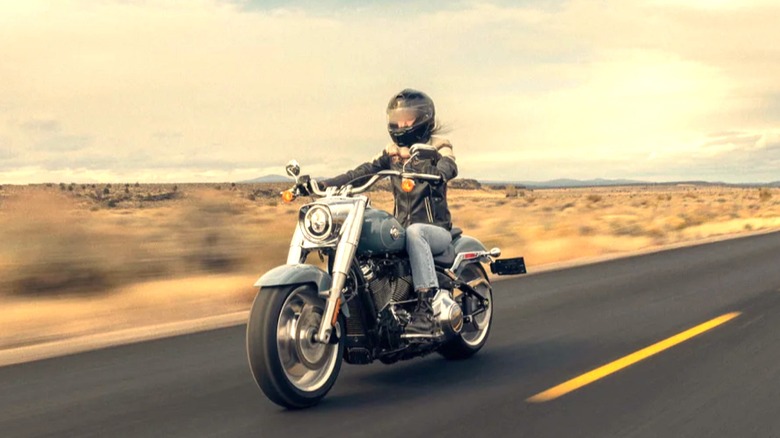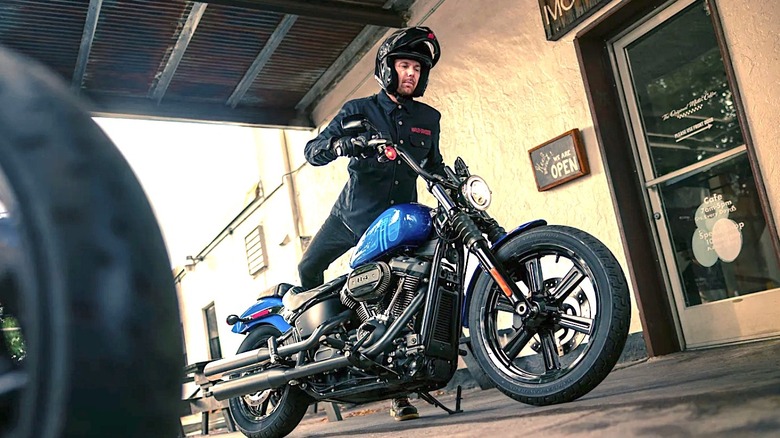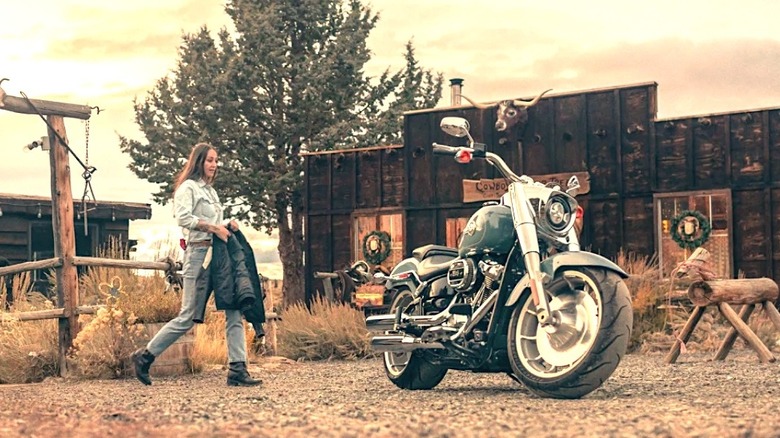Harley-Davidson Fat Boy Vs Street Bob: What's The Difference Between These Bikes?
There is perhaps no name in the American motorcycle game as prominent or as respected as Harley-Davidson, and that reputation may well extend to all corners of the motorcycle market. Even a casual glance at the manufacturer's iconic lineup of bikes will confirm why, with the company producing some of the best-loved two-wheeled vehicles to hit the road since its founding in 1903.
Among the more revered, and long-tenured offerings in the current stable of Harley-Davidson offerings are the brilliantly named Fat Boy and Street Bob, which the company has had in production in some form since 1990 and 2006, respectively. Each bike has, of course, seen significant upgrades since making their debuts in the Harley-Davidson lineup, though the overall looks of the Fat Boy and Street Bob have never deviated too far from their predecessors. As both bikes are cut from the softail cruiser cloth, they share similar design lines.
However, a closer comparison between the two bikes will quickly reveal that the differences between Harley-Davidson's Fat Boy and Street Bob are many, to say the least. In fact, apart from the softail chassis and a shared Milwaukee-Eight 114 engine, the bikes don't have much in common at all. Here's a look at the differences between Harley-Davidson's Fat Boy and the Street Bob.
The Street Bob is a slim, trim treat fit for beginners and seasoned road dogs alike
We'll start with the Harley-Davidson Street Bob, as it's the cheaper bike of the two, with a base model costing a reasonable $16,999. That price-point understandably makes the bike enticing for prospective new riders who have little to no practical experience operating a motorcycle. If you count yourself among that lot, the good news is that the Street Bob is well-regarded as a user-friendly, easy to handle bike, making it a suitable selection for first-timers. Likewise, even if you're a seasoned pro looking for a plucky motorcycle for cruising around the city, it should pack enough power and audible punch to make you feel like you're still riding a Harley.
As for the relatively stripped-down simplicity of the Street Bob's design, it can be traced back to the bike's spiritual predecessors, with Harley-Davidson's design team reportedly taking inspiration from the "bobbers" the company had designed for the US Military during World War II. The name itself is a reflection of the bike's clipped fenders and minimalist looks, with "bobbers" jettisoning design features deemed unnecessary to make lighter, maneuverable bikes that also allow for a surprising amount of customizability.
Though stripped down to the bare necessities, the upright riding Street Bob is still a sight to behold, with its mini-ape handle bars, exposed blacked-out machining, and variety of paint color options ensuring you'll turn a few heads when cruising down the road. However, the Street Bob's slim, shorter build may be a little snug for some larger riders, so you'll want to consider that if you're thinking about buying one.
The Fat Boy is a hulking bike built for cruising in relative comfort
The first thing you're likely notice about Harley-Davidson's Fat Boy is its hulking frame and wide wheels. After all, those features are what gave the Fat Boy motorcycle its famous name, and they continue to make it a standout both on the road, and in films like Terminator 2 and Wild Hogs. The 2024 Fat Boy has maintained the model's iconic look, meaning it's noticeably longer, wider, and heavier than the Street Bob. In comparison to the stripped-down bobber, it's also significantly more tricked-out, while the bike's low-to-the-ground build and wide-body Michelin Scorcher 11 tires make it a street-hugging dream for those in the saddle.
Despite its weight and build, it seems the Fat Boy somehow also manages to match the Street Bob in fuel economy, with each coming in at just under 43 miles per gallon (or 5.5 l/100km). Perhaps more importantly, the Fat Boy offers a relaxed riding position, and floor-boarded foot controls, which make it better-suited for proper freeway cruising. As the Fat Boy currently boasts the same Milwaukee-Eight 114 engine, you won't need to sacrifice muscle in the name of comfort, though it should be noted that the bike's heavier frame may make it a little more difficult to maneuver when you're charging down the road.
It's worth noting that there is also a substantial price difference between the Street Bob and the Fat Boy, with a base model of the latter running just under $22,000. So, if you're torn between the two, you may simply need to ask yourself if the extra money is worth the relative comfort, and, of course, the prestige that comes with riding a Harley-Davidson Fat Boy.


